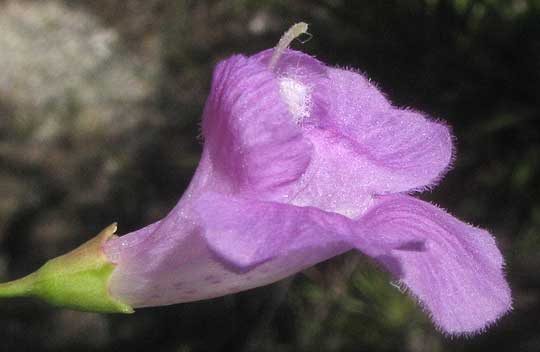Excerpts from Jim Conrad's
Naturalist Newsletter

from the the October 7, 2012 Newsletter issued from the valley of the Dry Frio River in northern Uvalde County, southwestern Texas, on the southern border of the Edwards Plateau; elevation ~1750m (~5750 ft); N29.62°, W99.86°; USA
PLATEAU AGALINIS
Atop nearby windswept limestone hills and on thin soil atop limestone ledges nowadays there's a dazzling display of untold numbers of thimble-sized, pale purple, snapdragon-like flowers held on very slender stems and with very small, fine leaves. Seeing them glowing in sunshine and dancing in wind is very pleasing. You can get a tiny notion of what it's like in a photo of a tiny part of a house-size thicket of the plants at a ledge's edge above.
A side-view of a blossom with its typically upturned corolla and its style projecting just beyond the corolla's upper lip is shown below:

A view down the throat of the above blossom showing very hairy anthers sheltering beneath the corolla's upper lip is below:

Despite this plant being absolutely abundant in thin soil atop limestone, the species is narrowly endemic just to a handful of counties in south-central Texas -- basically the southern portion of the Edwards Plateau. For that reason it's called the Plateau Agalinis, Plateau Gerardia and Plateau False-Foxglove. It's AGALINIS EDWARDSIANA.
When I arrived here in late August already it was conspicuously flowering, but it seems to have reached a peak of floriferousness impossible to exceed right now.
Even though in Nature the Plateau Agalinis seldom occurs out of its thin-soil-over-limestone habitat, it's regarded as an excellent wildflower for gardens, where their seeds can be sown directly, or else plants can be grown in pots for latter transplanting. The species is a larval and nectar plant for the Common Buckeye Butterfly, plus I see many other butterfly and bee species visiting them enthusiastically.
This is simply a wonderful wildflower deserving to be grown far beyond its limited natural distribution.